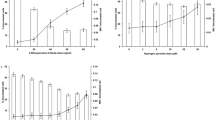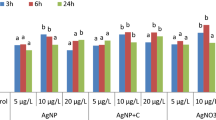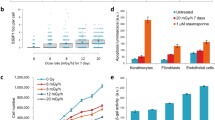Abstract
There is currently a great interest in delayed chromosomal and other damaging effects of low-dose exposure to a variety of pollutants which appear collectively to act through induction of stress-response pathways related to oxidative stress and ageing. These have been studied mostly in the radiation field but evidence is accumulating that the mechanisms can also be triggered by chemicals, especially heavy metals. Humans are exposed to metals, including chromium (Cr) (VI) and vanadium (V) (V), from the environment, industry and surgical implants. Thus, the impact of low-dose stress responses may be larger than expected from individual toxicity projections. In this study, a short (24 h) exposure of human fibroblasts to low doses of Cr (VI) and V (V) caused both acute chromosome damage and genomic instability in the progeny of exposed cells for at least 30 days after exposure. Acutely, Cr (VI) caused chromatid breaks without aneuploidy while V (V) caused aneuploidy without chromatid breaks. The longer-term genomic instability was similar but depended on hTERT positivity. In telomerase-negative hTERT− cells, Cr (VI) and V (V) caused a long lasting and transmissible induction of dicentric chromosomes, nucleoplasmic bridges, micronuclei and aneuploidy. There was also a long term and transmissible reduction of clonogenic survival, with an increased β-galactosidase staining and apoptosis. This instability was not present in telomerase-positive hTERT+ cells. In contrast, in hTERT+ cells the metals caused a persistent induction of tetraploidy, which was not noted in hTERT− cells. The growth and survival of both metal-exposed hTERT+ and hTERT− cells differed if they were cultured at subconfluent levels or plated out as colonies. Genomic instability is considered to be a driving force towards cancer. This study suggests that the type of genomic instability in human cells may depend critically on whether they are telomerase-positive or -negative and that their sensitivities to metals could depend on whether they are clustered or diffuse.
This is a preview of subscription content, access via your institution
Access options
Subscribe to this journal
Receive 50 print issues and online access
$259.00 per year
only $5.18 per issue
Buy this article
- Purchase on Springer Link
- Instant access to full article PDF
Prices may be subject to local taxes which are calculated during checkout






Similar content being viewed by others
References
Andreassen PA, Lohez OD, Margolis RL . (2003). Mutat Res 532: 245–253.
Baird DM, Rowson J, Wynford-Thomas D, Kipling D . (2003). Nature Genet 33: 203–207.
Bindra RS, Glazer PM . (2005). Mutat Res 569: 75–85.
Blackburn EH . (2001). Cell 106: 661–673.
Blasco MA, Lee HW, Hande MP, Samper E, Lansdorp PM, DePinho RA et al. (1997). Cell 91: 25–34.
Cabuy E, Newton C, Roberts T, Newbold R, Slijepcevic P . (2004). Cytometry 62A: 150–161.
Chan SW, Blackburn EH . (2003). Mol Cell 11: 1379–1387.
Cheng RYS, Zhao A, Alvord WG, Powell DA, Bare RM, Masuda A et al. (2003). Toxicol Appl Pharmacol 191: 22–39.
Coen N, Mothersill C, Kadhim M, Wright EG . (2001). J Pathol 195: 293–299.
Coen N, Kadhim MA, Wright EG, Case CP, Mothersill CE . (2003). Br J Cancer 88: 548–552.
Corinna M, Palanca-Wessels A, Klingelhutz A, Reid BJ, Norwood TH, Opheim KE et al. (2003). Carcinogenesis 24: 1183–1190.
Cui W, Aslam S, Fletcher J, Wylie D, Clinton M, Clark AJ . (2002). J Biol Chem 277: 38531–38539.
Dimri GP, Lee X, Basile G, Acosta M, Scott G, Roskelley C et al. (1995). Proc Natl Acad Sci USA 92: 9363–9367.
Dutrillaux B, Gerbault-Sereau M, Remvikos Y, Zafrani B, Prieur M . (1991). Breast Cancer Res Treat 19: 245–255.
Fenech M . (2000). Mutat Res 455: 81–95.
Fenech M, Morley AA . (1985). Mutat Res 148: 29–36.
Gorbunova V, Seluanov A, Pereira-Smith OM . (2002). J Biol Chem 41: 38540–38549.
Ha L, Ceryak S, Patierno SR . (2004). Carcinogenesis 11: 2265–2274.
Hackett JA, Feldser DA, Greider CW . (2001). Cell 106: 275–286.
Hardin J, Hilde J . (2001). College Station. Stata Press: TX, USA.
Henegariu O, Heerema NA, Lowe Wright L, Bray-Ward P, Ward DC, Vance GH . (2001). Cytometry 43: 101–109; http://www.osha.gov/SLTC/healthguidelines/vanadiumpentoxidedust/recognition.html#workplacemonitoring.
IARC (International Agency for Research on Cancer) (1990). Monograph on the Evaluation of Carcinogenic Risk to Humans, Chromium. Nickel and Welding: Lyon, France.
Ivancsits S, Pilger A, Diem E, Schaffer A, Rudiger HW . (2002). Mutat Res 519: 25–35.
Jiang XR, Jimenez G, Chang E, Frolkis M, Kusler B, Sage M ; et al. (1999). Nat Genet 21: 111–114.
Kadhim MA, MacDonald DA, Goodhead SA, Lorimore SA, Marsden SJ, Wright EG . (1992). Nature 355: 738–740.
Karlseder J, Hoke K, Mirzoeva OK, Bakkenist C, Kastan MB, Petrini JH et al. (2004). PLoS Biol 2: E240.
Karlseder J, Smogorzewska A, de Lange T . (2002). Science 295: 2446–2449.
Kerr JFK, Harmon BV . (1991). Definition and incidence of apoptosis. An historical perspective. In: Tomei LD, Cope FO (eds). Apoptosis. The Molecular Basis of Cell Death. Cold Springs Harbour Laboratory: NY, pp 5–9.
Kim NW, Wu F . (1997). Nucleic Acids Res 25: 2595–2597.
Koizumi S, Yamada H . (2003). J Occup Health 45: 331–334.
Lanni JS, Jacks T . (1998). Mol Cell Biol 18: 1055–1064.
Little JB . (2003). Oncogene 22: 6978–6987.
Luther MJ, Davies E, Muller D, Harrison M, Bone AJ, Persaud SJ et al. (2005). Am J Physiol Endocrinol Metab 288: E502–E509.
McClintock B . (1941). Genetics 26: 234–282.
McIlrath J, Bouffler SD, Samper E, Cuthbert A, Wojcik A, Szumiel I et al. (2001). Cancer Res 61: 912–915.
Mese H, Ueyama Y, Suzuki A, Nakayama S, Sasaki A, Hamakawa H et al. (2001). Chemotherapy 47: 136–142.
Morales CP, Holt SE, Ouellette M, Kaur KJ, Yan Y, Wilson KS et al. (1999). Nat Genet 21: 115–118.
Mothersill C, Crean M, Lyons M, McSweeney J, Mooney R, O'Reilly J et al. (1998). Int J Rad Biol 74: 673–680.
Mothersill C, Seymour C . (2004). Mutat Res 568: 121–128.
National Institute for Occupational Safety and Health (NIOSH). (1997). NIOSH Pocket Guide to Chemical Hazards. US Department of Health and Human Services, Public Health Service, Centre for Disease Control and Prevention: Washington, DC.
Nicoletti L, Migliorati G, Pagliacci MC, Grignani F, Riccardi C . (1991). J Immun Meth 139: 271–279.
Nijjar T, Bassett E, Garbe J, Takenaka Y, Stampfer MR, Gilley D et al. (2005). Oncogene 24: 3369–3376.
Noble JR, Zhong ZE, Neumann AA, Melki JR, Clark SJ, Reddel RR . (2004). Oncogene 23: 3116–3121.
Obe G, Pfeiffer P, savage JRK, Johannes C, Goedecke W, Jeppesen P et al. (2002). Mutat Res 504: 17–36.
O'Brien TJ, Ceryak S, Patierno SR . (2003). Mutat Res 533: 3–36.
Park HR, Min SK, Cho HD, Kim KH, Shin HS, Park YE . (2004). J Cutan Pathol 31: 544–549.
Piboonniyom S, Duensing S, Swilling NW, Hasskarl J, Hinds PW, Munger K . (2003). Cancer Res 63: 476–483.
Pritchard DE, Ceryak S, Ha L, Fornsaglio JL, Hartman SK, O'Brien TJ et al. (2001). Cell Growth Differ 12: 487–496.
Puck TT, Marcus PI . (1956). J Exp Med 103: 653–666.
Rajagopalan H, Lengauer C . (2004). Nature 432: 338–341.
Ramirez P, Eastmond DA, Laclette JP, Ostrosky-Wegman P . (1997). Mutat Res 386: 291–298.
Reid BJ, Haggitt RC, Rabinovitch PS . (1987). Gasroenterology 93: 1–11.
Risques RA, Moreno V, Ribas M, Marcuello V, Capella G, Peinado M . (2003). Cancer Res 63: 7206–7214.
Rubio MA, Kim SH, Campisi J . (2002). J Biol Chem 277: 28609–28617.
Rubio MA, Davalos AR, Campisi J . (2004). Exp Cell Res 298: 17–27.
Sabatier L, Lebeau J, Dutrillaux B . (1994). Int J Rad Biol 66: 611–613.
Sciandrello G, Caradonna F, Mauro M, Barbata G . (2004). Carcinogenesis 25: 413–417.
der-Sarkissian H, Bacchetti S, Cazes L, Londono-Vallejo JA . (2004). Oncogene 23: 221–228.
Seone AI, Dulout FN . (2001). Mutat Res 490: 99–106.
Seymour CB, Mothersill C, Alper T . (1986). Int J Rad Biol 50: 167–169.
Seymour CB, Mothersill C, Mooney R, Moriarty M, Tipton KF . (2003). Br J Cancer 89: 1979–1986.
Shi Q, King RW . (2005). Nature 437: 1038–1042.
Smorgorzewska A, Karlseder J, Holtgreve-Grez H, Jauch A, de Lange T . (2002). Curr Biol 12: 1635–1644.
Sorensen M, Schinns RPF, Hertel O, Loft S . (2005). Cancer Epidemiol Biomarkers Prev 14: 1340–1343.
van Steensel B, Smogorzewska A, de Lange T . (1998). Cell 92: 401–413.
Storchova Z, Pellman D . (2004). Nat Rev Mol Cell Biol 5: 45–54.
Sugden KD, Stearns DM . (2000). J Environ Pathol Toxicol Oncol 19: 215–230.
Thomas P, Umegaki K, Fenech M . (2003). Mutagenesis 18: 187–194.
Tsuneta Y, Ohsaki Y, Kimura K, Mikami H, Abe S, Murao M . (1980). Thorax 35: 294–297.
Tsutsui T, Kumakura S, Yamamoto A, Kanai H, Tamura Y, Kato T et al. (2002). Carcinogenesis 23: 2111–2117.
Urushibara A, Kodama S, Suzuki K, Desa MBM, Suzuki F, Tsutsui T et al. (2004). Biochem Biophys Res Comm 313: 1037–1043.
Uetake Y, Sluder G . (2004). J Cell Biol 165: 609–615.
Wong C, Stearns T . (2005). BMC Cell Biol 6: 6.
Wood LD, Halvorsen TL, Dhar S, Baur JA, Pandita RK, Wright WE et al. (2001). Oncogene 20: 278–288.
World Health Organisation (2001). Vanadium Pentoxide and Other Inorganic Vanadium Compounds. Concise International Chemical Assessment Documents (Document 29).
Zhang Y, Cao EH, Qin JF . (2005). Eur J Pharmacol 516: 1–9.
Author information
Authors and Affiliations
Corresponding author
Additional information
Supplementary Information accompanies the paper on Oncogene website (http://www.nature.com/onc).
Supplementary information
Rights and permissions
About this article
Cite this article
Glaviano, A., Nayak, V., Cabuy, E. et al. Effects of hTERT on metal ion-induced genomic instability. Oncogene 25, 3424–3435 (2006). https://doi.org/10.1038/sj.onc.1209399
Received:
Revised:
Accepted:
Published:
Issue Date:
DOI: https://doi.org/10.1038/sj.onc.1209399
Keywords
This article is cited by
-
Toxicity of inorganic vanadium compounds
Research on Chemical Intermediates (2015)
-
Radiation-induced bystander effects in the Atlantic salmon (salmo salar L.) following mixed exposure to copper and aluminum combined with low-dose gamma radiation
Radiation and Environmental Biophysics (2014)
-
The metal ion theory of ageing: dietary target hazard quotients beyond radicals
Immunity & Ageing (2008)



